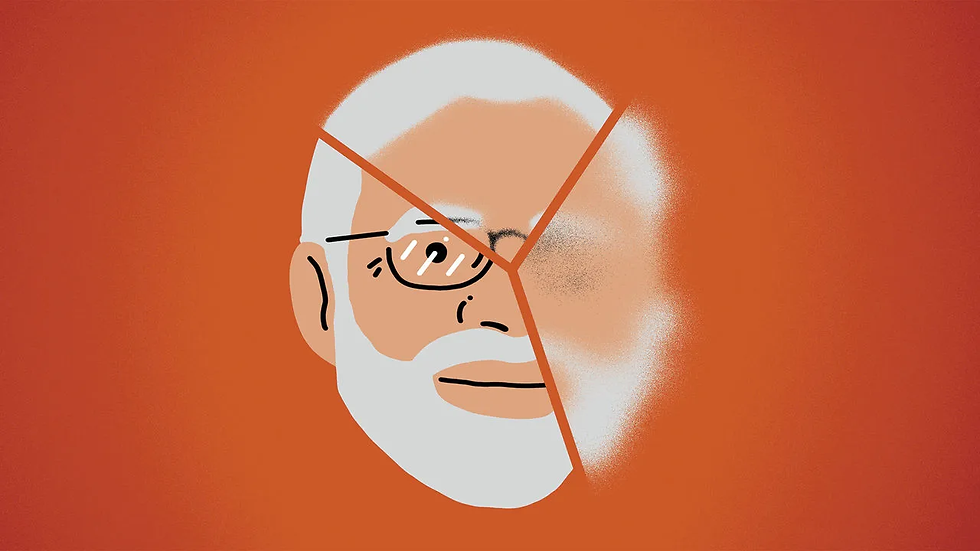The 'Gujaratification' of India
- Vedant Mangal
- Jun 14
- 3 min read
When Narendra Modi shifted from Gujarat to Delhi in 2014, it was not a geographical shift alone. It was a shift in ambition. For over a decade, he had run Gujarat like a CEO, tight, controlled, and efficient. Industries had grown, roads increased, and big-ticket projects seemed to materialize from nowhere. To many, especially business leaders and middle-class voters, Gujarat had become a success story. So when Modi took the reins of India, it wasn’t surprising that he tried to take Gujarat with him.
From the very beginning, it felt like Modi was trying to transplant a familiar playbook onto a much messier, more chaotic canvas. He wasn’t stepping into a vacuum, India already had its own rhythms, its own complexities, but he brought with him a sense of purpose that seemed honed in the dry, industrious air of Gandhinagar.

Consider “Make in India”, for instance. The branding was slick, the promise big: turn India into a manufacturing powerhouse. It echoed what Modi had done in Gujarat, creating industrial corridors, wooing foreign investors, setting up summits that looked more like international expos. The idea was simple: make things easier for businesses, and they’ll take care of the rest. In Gujarat, that mostly worked. In India? Well, the results have been more mixed. Some factories came. Some jobs followed. But the transformation hasn’t quite hit the scale Modi envisioned.
Infrastructure, though, that’s where the Gujarat DNA is hard to miss. Flyovers, highways, expressways, smart cities, even bullet trains. Modi sees development in concrete and steel. He always has. When he talks about building a new India, he often talks like a civil engineer. And in some ways, it's infectious, there’s a visible pride in newly laid roads or gleaming airports. It’s tangible. You can point at it and say, “There, that’s progress.”
But perhaps the biggest mark of the Gujarat model isn't in what was built, but in how things are run. In Gujarat, Modi was known for running a tight ship. Ministers had limited independence, decisions flowed downward, and the Chief Minister’s office was where the real power sat. As Prime Minister, he’s replicated that model on a grander scale. The PMO is now the epicentre of most big decisions. Ministries execute, but the vision comes from the top. This has meant speed, sure—but also criticism, especially from those who believe in stronger state autonomy or a more collaborative federal structure.

The same control extends to how Modi communicates. He rarely gives unscripted interviews. He doesn’t take press questions. But he speaks directly to the people through radio broadcasts, social media, and carefully crafted speeches. It’s the same approach he used in Gujarat: bypass the traditional media filters and speak to the public in your own voice. Love it or hate it, it works. Millions tune in. The narrative remains his.
And still, as he's attempted to replicate the Gujarat model, there have been pains of growth. India is not Gujarat. Gujarat is less religiously diverse in many respects and more urban and industrial. And so policies that had seemed efficient or evenhanded in one setting don't always translate elsewhere. The Citizenship Amendment Act (CAA), for instance, discriminatory, in the view of critics, and necessary, according to its supporters, caused protests and unrest in a few areas of India. The Gujarat model is, indeed, a model. It's not going to be a perfect fit for everyone.

Even in welfare, there’s a very Modi-Gujarat fingerprint. He prefers programs with numbers. Gas cylinders distributed. Toilets built. Houses completed. It’s governance as performance metrics—quantifiable, trackable, visual. That’s not inherently bad, and in fact, many of these programs have improved lives. But they also sometimes miss the deeper, slower, harder-to-measure parts of social development: better health outcomes, higher literacy, more inclusive opportunities.
So what does it mean to lead India with a Gujarat mindset? On one hand, it brings clarity. Modi believes in order, in scale, in building things that last. On the other hand, it can feel like trying to apply the logic of a well-oiled factory to a sprawling, unpredictable ecosystem.
Ten years in, Modi’s attempt to make India more like Gujarat is still unfolding. He’s succeeded in putting infrastructure and governance on steroids. He’s made the PM’s office more powerful than it’s been in decades. He’s put his own brand of nationalism at the center of public discourse. But he’s also had to learn—sometimes painfully—that running a country of 1.4 billion isn’t the same as running one ambitious state.

In the end, maybe this isn’t just about whether India can become more like Gujarat. Maybe it’s about how one leader can imprint his vision onto a country that constantly resists simplification. Modi tried to take what worked in Gujarat and lift it, scale it, and superimpose it on India. In some places, it clicked. In others, it collided with reality.





